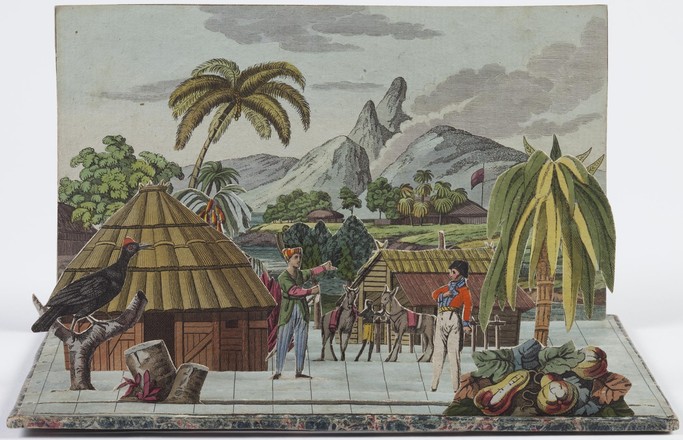Naturgemählde
is the first (and
seemingly only) edition of a very rare German-language children’s book printed
in Austria by Heinrich Friedrich Müller (1779-1848), a Viennese
innovator in printing technology and publisher who produced the first German
picture-book. The 1827 Naturgemählde
was designed by Austrian educationalist and author-illustrator Leopold Chimani
(1774-1844) as an interactive way to teach children geography.
Divided into five sections
(Europe, Asia, Africa, America, Australia), the book endeavours to hold the
young reader’s attention with spirited accounts in the form of short chapters
on social customs, natural phenomena and discoveries by European explorers,
interspersed with exciting narratives of adventure dealing with subjects such
as pirates, cannibals, volcanoes and wild animals including polar bears, lions
and kangaroos.
However, it is the scored grid,
or display board, accompanying the printed volume, that provides the most
extraordinary aspect of Chimani’s design for the early interactive geography
book. It is into this display board that the child is intended to place dozens
of coloured cut-out figures, with a backdrop behind, thereby creating five
different tableaux to illuminate ‘theatrically’ what he or she has read. Each
of the cut-out pieces for use with the 5 tableaux has a Roman numeral printed
on the base which indicates the tableau to which it belongs. Coordinates
printed on the tab at the foot of each figure show where the figure should be
placed on the grid. The cut outs can be manipulated to create an endless
variety of exciting factual, or fanciful, scenes of faraway places.
The Australia tableaux (on show
in AMAZE) has a total of 16 pieces and shows two European figures – Captain
James Cook and Georg Forster – encountering South Sea natives. Of these 16
pieces, Captain Cook is depicted as the figure in the red jacket, one represents
two Europeans (including Forster), three depict Australian Aborigines, one
represents a Maori man, one represents a Tahitian couple, three represent
structures (two dwellings, one of which could possibly depict an Aboriginal
shelter, and one possibly the fence to a Maori compound), and the remaining
five represent various types of vegetation, from small flowering plants to palm
trees and perhaps an Australian native tree (eucalyptus).
The exploits of Captain James
Cook were greatly admired world-wide with his journals providing sources for
informative accounts about his three Pacific voyages for both children and
adults. In 1772-75, when Joseph Banks refused to sail on Cook’s second
expedition, the naturalist Johann Reinhold Forster (1729-1798) took his place,
his son Georg Forster (1754-1794) accompanied him as his assistant. It was
Cook’s triumphant return from his second circumnavigation – the arduous and
challenging three year Antarctic voyage of the Resolution (1772-1775) – that
made him the most accomplished explorer of the eighteenth century.
In March 1787, eight years
after Cook’s death in Hawaii, Georg Forster completed his German translation of
the official account of Cook’s third voyage which included his introductory
essay, Cook der Endecker, drawn from
his personal experience of sailing with the second voyage. Fifty years on, the
Viennese producers of this unique German-language publication were sufficiently
astute to exploit this nationalistic connection to eighteenth century Europe’s greatest
explorer.
The America tableau depicts a
frontier fort and indigenous people, in Africa a lion chases a man while in
Asia mischievous monkeys play as a tiger tussles with a snake.



 Back to list
Back to list